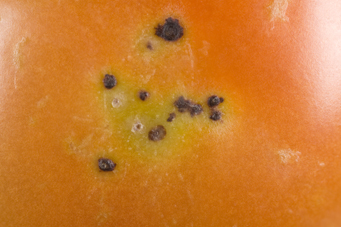Bacterial speck
Bacterial speck, also known as Xanthomonas campestris pv. vesicatoria, Pseudomonas syringae pv. Tomato. Bacterial speck and spot are very difficult to distinguish from each other. However the control strategies are the same and both diseases attack the above ground organs of the plant.
Bacterial speck symptoms
Small water soaked lesions which develop during periods of rain, dew or irrigation. Lesions seldom exceed 3mm in diameter and quickly turns round and brown. Fruit lesions are usually elevated. In some cases the lesions may be surrounded by a yellow halo. Only green tissue is infected. If lesions occur on the ripe fruit, infection took place when the fruit was still immature.
Bacterial spec differs from bacterial spot that lesions are initially much smaller. Lesions are small, round and brown to black in appearance. The disease is characterized by the fact that the surrounding tissue has a more intense green colour. In comparison to bacterial spot, the lesions are smaller and the disease might be seed borne. Bacterial spec and spot can occur in combination, in which case the stem is mainly affected. The characteristic symptom is a total necrosis of the outer surface of the stem. Infection starts as a light black lesion until the whole stem turns black and resembles late blight. In the process the whole stem above the lesion dies back.
Bacterial spot control
- Do not plant infected seedlings.
- Obtain seed from a reputable supplier
- Follow a weekly spraying program with registered copper containing compounds.
- Avoid water dripping from inside tunnels on leaves (Also called greenhouse effect). Use anti fogging plastic material.
- If you have bacterial spot under control you will have bacterial speck in control since bacterial spot chemicals work for both diseases.



